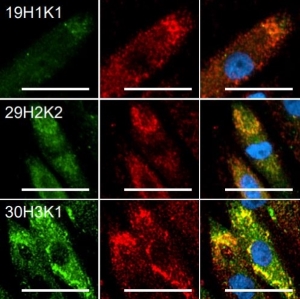ABCA1
You are doing some amazing research. I'm excited to share with you a small sampling of the interesting research being done with Neuromics solutions.
First I'd like to share a recent publication using our ABCA1 Antibody: Jianjia Fan, Rui Qi Zhao, Cameron Parro, Wenchen Zhao, Hsien-Ya Chou, Jerome Robert, Tarek Z. Deeb, Carina Raynoschek, Samantha Barichievy, Ola Engvist, Marcello Maresca, Ryan Hicks, Johan Meuller, Stephen J. Moss, Nicholas J. Brandon, Michael W. Wood, Iva Kulic, Cheryl L. Wellington. (2018). Small molecule inducers of ABCA1 and apoE that act through indirect activation of the LXR pathway. Journal of Lipid Research. doi: 10.1194/jlr.M081851

More Publications
Fenghua Bao, Chang-Lin Li, Xu-Qiao Chen, Ying-Jin Lu, Lan Bao, and Xu Zhang. (2018). Clinical Opioids Differentially Induce Co-Internalization of μ- and δ-Opioid Receptors. Molecular Pain. doi: https://doi.org/10.1177/1744806918769492
This study looked at co-internalization of MOR and DOR when exposed to the clinal MOR-targeting opioids of morphine, fentanyl, methadone, and tramadol.
Nicola Montalbetti, James G Rooney, Allison L. Marciszyn, and Marcelo D. Carattino. (2018) ASIC3 fine-tunes bladder sensory signaling. American Journal of Physiology-Renal Physiology. 21 MAR 2018https://doi.org/10.1152/ajprenal.00630.2017
This study looked at the role ASIC3 plays in control of bladder function.
Fig. AZ-1 and AZ-2 induce ABCA1 in other CNS cells that lack detectable P2X7. (A) Primary human astrocytes (hAstrocyte), (B) human microglia cell line HMC3, and (C) primary human brain vascular pericytes (hPericyte) were treated with DMSO, 1 µM GW3965, 10 µM AZ-1 or AZ-2 for 72 h. (A-C) Top panels: Representative immunoblots of cellular ABCA1 and P2X7 protein levels. Wild-type HEK293 (HEK-WT) and transfected HEK293 over-expressing human P2X7 receptors (HEK-P2X7) were used as negative and positive controls for P2X7 detection. GAPDH serves as the loading control. doi: 10.1194/jlr.M081851






